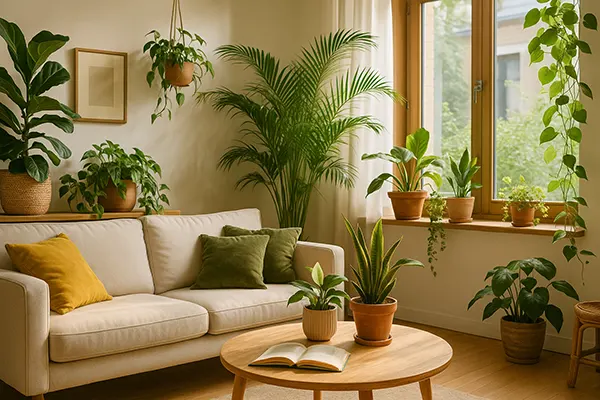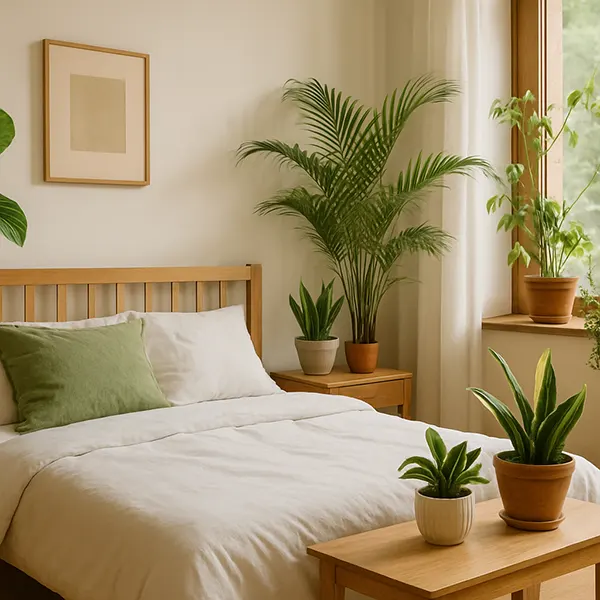
Biophilic Design in Daily Life: How Nature at Home Supports Mental Health
Incorporating natural elements into interior design is more than just an aesthetic trend — it’s a scientifically supported way to promote psychological well-being. Known as biophilic design, this concept centres around humans’ inherent need to connect with nature. By bringing greenery, natural light, and organic materials into our homes, we can create environments that soothe stress, enhance cognitive function, and contribute to better mental balance. In the context of urbanisation and screen-saturated lifestyles, the relevance of biophilic principles has only grown.
Scientific Foundations of Biophilic Design
Studies across environmental psychology and neuroscience affirm that exposure to nature — even in artificial indoor settings — reduces cortisol levels and slows the heart rate. A review published in *Environmental Health Perspectives* (2023) emphasises how even brief contact with indoor plants or natural views can lower anxiety and improve mood. These findings align with Edward O. Wilson’s biophilia hypothesis, which posits that humans are biologically predisposed to seek connections with life forms and ecosystems.
According to a 2025 meta-analysis conducted by the University of Cambridge, individuals living in homes that incorporate natural textures and vegetation report 21% fewer depressive symptoms than those in non-biophilic settings. The visual and tactile stimulation provided by natural elements activates parasympathetic nervous system responses — promoting calm and clarity.
Moreover, the presence of natural daylight, especially through south-facing windows or skylights, supports circadian rhythm regulation. This enhances sleep quality and helps stabilise emotional states over time, which is especially crucial for individuals working remotely or those with limited outdoor access.
Indoor Nature and Its Impact on Focus and Stress Levels
Natural features within the home can significantly affect concentration, creativity, and stress resilience. According to the 2024 Global Wellness Institute report, homes with integrated biophilic features show up to 15% higher productivity rates among remote workers and students. This is largely attributed to the calming effect of nature, which counteracts sensory overstimulation common in digital environments.
Plants like ferns, snake plants, and peace lilies are not only visually soothing — they also purify air and maintain indoor humidity, which contributes to a more pleasant microclimate. Additionally, water elements, such as tabletop fountains, provide auditory cues that mimic natural soundscapes and reduce perceived stress.
Even nature-inspired patterns and textures, such as wooden floors or stone walls, can trigger positive emotional responses. This is due to their association with safety and evolutionary comfort, as evidenced in numerous studies conducted within the fields of biophilic architecture and behavioural therapy.
Practical Ways to Apply Biophilic Design at Home
One does not need a luxury budget or a large space to adopt biophilic design principles. Simple interventions — such as adding indoor plants to workspaces or positioning furniture near natural light — can yield significant benefits. The goal is to foster visual and sensory access to natural cues throughout the living environment.
For instance, incorporating wooden or clay materials in furniture, utensils, and even decorative elements reinforces the tactile connection to nature. Meanwhile, strategically placing mirrors can maximise the presence of sunlight indoors. Using diffused light sources and avoiding synthetic lighting at night further supports mental restoration.
Another effective approach includes integrating natural scents like eucalyptus, lavender, or pine through essential oils or naturally derived diffusers. These scents are known for their calming properties and have been studied for their role in reducing symptoms of chronic stress and general anxiety disorders.
Designing Restorative Zones in Compact Spaces
Even small apartments can be adapted to support mental wellness through biophilic design. Creating a ‘green corner’ with vertical gardens or hanging plants can act as a visual break in compact rooms. Such corners offer a retreat space that enhances reflection and relaxation without requiring square footage expansion.
In bedrooms, prioritising breathable textiles such as organic cotton or linen can improve sleep quality while adding visual softness. These fabrics are also hypoallergenic and conducive to emotional comfort. Incorporating natural imagery in art or wallpaper can further emulate the presence of the outdoors.
For homes with limited window access, circadian lighting systems that simulate the daily light cycle can help maintain biological rhythms. These systems are increasingly affordable and accessible, with programmable settings that align artificial lighting with natural sleep-wake cycles.

The Future of Mental Health and Urban Living
As urbanisation intensifies and lifestyles become increasingly sedentary, the need for nature within indoor spaces will only grow. Public health initiatives in 2025 are already recognising this. For instance, the World Health Organization has advocated for the inclusion of green design principles in social housing to combat urban mental health challenges.
Real estate developers in cities like Copenhagen, Singapore, and Amsterdam are investing in biophilic housing schemes that blend vegetation, water features, and natural materials into high-density living. These models aim to create not only sustainable but also mentally nourishing environments.
Such trends point to a paradigm shift: interior design is no longer merely about style — it is now seen as a vital contributor to holistic health. Home environments are being redefined as therapeutic spaces that can proactively support emotional balance and resilience against daily stressors.
Educational and Workplace Integration of Biophilic Concepts
Beyond homes, biophilic design is gaining traction in schools and office environments. Classrooms enriched with plants and natural lighting are shown to improve students’ test scores and decrease behavioural issues. In 2024, a study by the British Council for School Environments reported a 14% drop in absenteeism when greenery was introduced to learning spaces.
Workplaces that embrace natural materials, views of greenery, and open-air designs report lower burnout rates and improved morale. The integration of nature into shared spaces supports collaboration, reduces conflict, and enhances overall productivity. As hybrid work becomes the norm, these benefits have become central to organisational well-being strategies.
Thus, from individual homes to institutional design, biophilic principles are shaping a future where natural harmony becomes an anchor for psychological health and community resilience.
